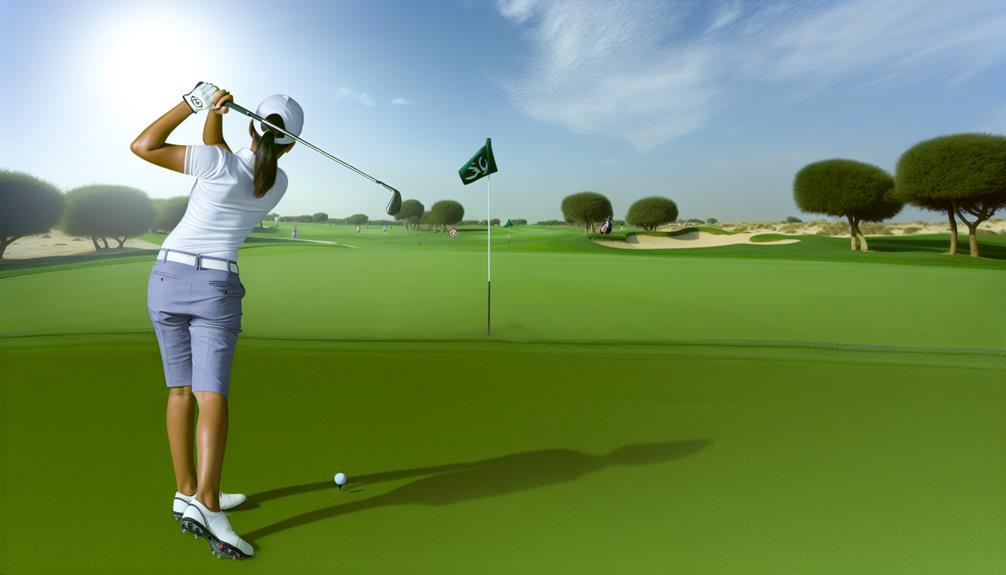Just as a chess player studies the board before making a move, navigating the putting green is a strategic part of golf that requires you to know and understand the rules.
It's not just about skill and precision, but also about etiquette and respect for the game. You've probably got a handle on the basics of golf, but are you familiar with the essential rules that govern the putting green?
These can make a significant difference in your game, and we're here to shed some light on them.
Are you ready to step up your game and master the finer points of putting green rules?
Understanding the Putting Green
Dive right into the heart of golf by understanding the putting green, a critical area that can make or break your game. This area, often mowed to near perfection, requires extensive green maintenance. It's not just about aesthetics. The smoother the surface, the better your ball will roll.
Now, let's talk about your putting techniques. You've got to read the green accurately. Pay close attention to the subtlest slopes and undulations. They can greatly affect the path of your ball. Distances can be deceptive on this finely manicured turf, so practice judging distances accurately. Remember, your goal is to sink the ball in as few strokes as possible.
Next, consider your stroke mechanics. Keep your wrists firm and maintain a consistent grip pressure throughout your stroke. Ensure your eyes are directly above the ball and your putter face is square to your chosen line. And don't forget, confidence is key on the green. Trust your read, your judgement and your stroke.
Rule of Marking the Ball
On the putting green, knowing how to properly mark your ball isn't just a matter of etiquette, but a crucial rule you'll need to follow to avoid penalties. Marking your ball incorrectly can result in unnecessary strokes added to your score, which is why understanding ball placement techniques is of utmost importance.
Before you lift your ball, place a marker directly behind it. Coin, tee, or specially designed ball markers are among the marking equipment choices you can use. Make sure your marker doesn't interfere with the play of others. If you're unsure, it's perfectly acceptable to ask a fellow player or a referee.
Next, lift your ball carefully. Avoid spinning or rolling it, as this could cause the marker to move. When it's time to replace your ball, it must be set down on the spot from which it was originally lifted. If it moves due to wind or slope after it's been replaced, don't worry – you're not penalized.
Lifting and Cleaning Golf Ball
Having mastered the art of marking your ball, it's crucial you also understand the rules regarding lifting and cleaning your ball on the green. After all, golf is a game of precision and every little factor counts.
You're allowed to lift your ball on the green, but there are conditions. Always mark the spot before you lift the ball. You can then proceed with ball sanitization practices. Cleaning the ball is important not only for hygiene but also for improved performance. A clean ball is more predictable and provides better control.
Wet terrain challenges are another aspect to consider. When playing on a damp course, your ball is likely to pick up mud or debris. The rules permit cleaning in such cases. However, you can't repair spike marks or other irregularities on your putting line.
Bear in mind, you should replace your ball on the exact spot from where it was lifted. If it moves after being replaced due to wind or gravity, you must play it from its new location.
Repairing Damage on Putting Green
In the realm of golf, it's essential you're well-versed in the rules for repairing damage on the putting green, as this could greatly impact your game's outcome. Green maintenance is a collective responsibility, so you must know how to correct any damage causes, whether they're divots, ball marks, or spike marks.
The first rule you must remember is that any damage to the putting green caused by your actions, such as ball marks or spike marks, should be repaired immediately. If you delay, the turf can deteriorate, impacting future play. Use a divot repair tool to push the damaged area towards the center, then gently tap down with your putter. It's simple, yet crucial.
Secondly, if you spot any damage, such as pitch marks or old hole plugs, you're allowed to repair them, even if they're not of your making. However, don't repair any damage that might aid another player's play, like aeration holes or worm casts, as this is against the rules.
Following these rules ensures a fair game for all players and contributes to the proper maintenance of the golf course. Remember, a well-kept green is an integral part of the game.
Handling Ball Interferences While Putting
When it comes to putting, you'll also need to handle potential interferences with your ball, such as when another ball on the green gets in your way. Mastering obstacle removal strategies is crucial for maintaining a smooth, unobstructed path to the hole.
If another ball obstructs your line of putt, you're allowed to have it lifted, provided it's on the putting green. However, ensure it's marked before being lifted, and replaced on its original spot afterwards.
Unexpected interference scenarios can also test your understanding of the rules. If, for instance, your ball is accidentally moved during the removal of another ball, it must be replaced without penalty. Similarly, if your ball or ball-marker is accidentally moved in the process of lifting or replacing a ball, you should also replace it without penalty.

